.jpg) Picasso said : "When I see Le déjeuner sur l'herbe, I'm saying to myself pain for the future". The realism of the subject is striking.
Picasso said : "When I see Le déjeuner sur l'herbe, I'm saying to myself pain for the future". The realism of the subject is striking. For the first time in history, you can't find any justification for the nude, any pretext from mythology.
For the first time in history, you can't find any justification for the nude, any pretext from mythology. The men are simply ignoring the woman, engaged in their conversation. The light of the paint is like a photographic light in studio,
The men are simply ignoring the woman, engaged in their conversation. The light of the paint is like a photographic light in studio,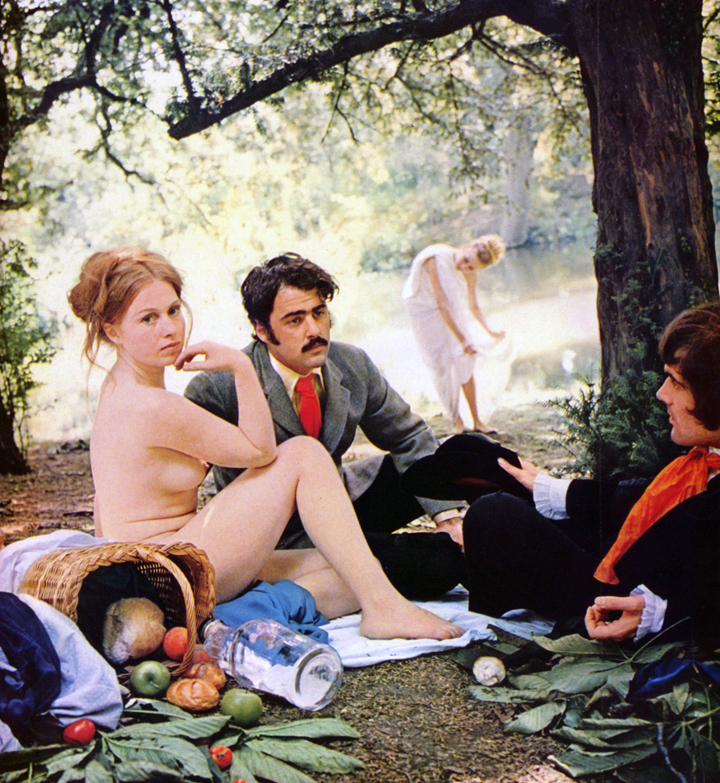 you do not see any shadow and the atmosphere is unnatural.
you do not see any shadow and the atmosphere is unnatural. 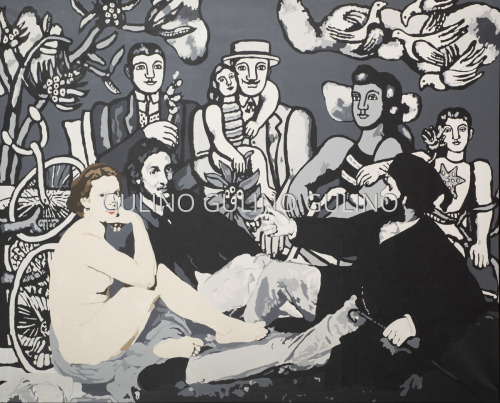 Strange also are the dress of the men, with indoor looks, rather than dressed for a summer lunch
Strange also are the dress of the men, with indoor looks, rather than dressed for a summer lunch .compare Edouard Manet's Dejeuner Sur L'herbe to Claude Monet's nude-less painting
.compare Edouard Manet's Dejeuner Sur L'herbe to Claude Monet's nude-less painting .title pictures serve as more than mere justification for an outing.
.title pictures serve as more than mere justification for an outing.
 Manet put great emphasis on Salon acceptance. Ironically, however, it was not Spanish
Manet put great emphasis on Salon acceptance. Ironically, however, it was not Spanish  Guitar Player which brought him his much sought after recognition but the rejected Dejeuner sur l'herbe (1863).
Guitar Player which brought him his much sought after recognition but the rejected Dejeuner sur l'herbe (1863).  The Salon jury of 1863 had been exceptionally brutal and thousands of paintings had been refused. To counter these refusals, the Salon des Refuses was established
The Salon jury of 1863 had been exceptionally brutal and thousands of paintings had been refused. To counter these refusals, the Salon des Refuses was established  and it was here that Dejeuner sur l'herbe (also known as theLuncheon on the Grass) was exhibited. Although influenced by Raphaeland Giorgione,
and it was here that Dejeuner sur l'herbe (also known as theLuncheon on the Grass) was exhibited. Although influenced by Raphaeland Giorgione, Dejeuner did not bring Manet laurels and accolades. It brought criticism. Critics found Dejuener to be anti-academic and politically suspect and the ensuing fire storm surrounding this painting has made Le Dejeuner sur l'herbe a benchmark in academic discussions of modern art. The nude in Manet's painting was no nymph, or mythological being...she was a modern Parisian women cast into a contemporary setting with two clothed man.
Dejeuner did not bring Manet laurels and accolades. It brought criticism. Critics found Dejuener to be anti-academic and politically suspect and the ensuing fire storm surrounding this painting has made Le Dejeuner sur l'herbe a benchmark in academic discussions of modern art. The nude in Manet's painting was no nymph, or mythological being...she was a modern Parisian women cast into a contemporary setting with two clothed man.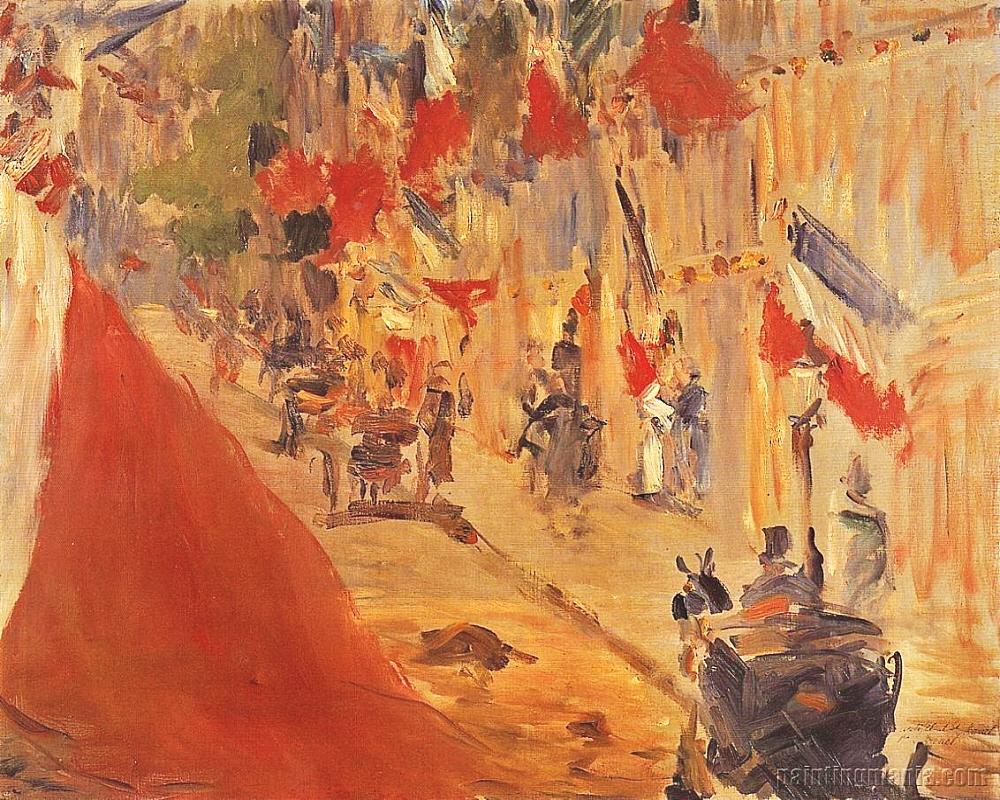 Many found this to be quite vulgar and begged the question "Who's for lunch?" The critics also had much to say about Manet's technical abilities. His harsh frontal lighting and elimination of mid tones rocked ideas of traditional academic training.
Many found this to be quite vulgar and begged the question "Who's for lunch?" The critics also had much to say about Manet's technical abilities. His harsh frontal lighting and elimination of mid tones rocked ideas of traditional academic training.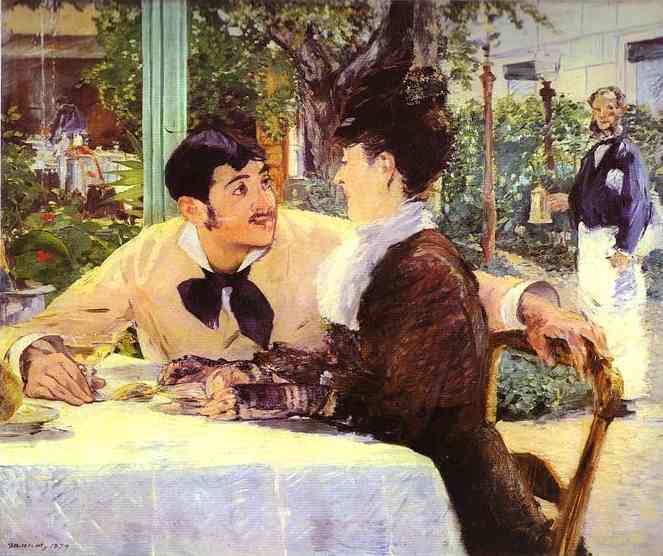 And yet, it is also important to understand that not everyone criticized Manet, for it was also Dejeuner which set the stage for the advent of Impressionism. Olympia,
And yet, it is also important to understand that not everyone criticized Manet, for it was also Dejeuner which set the stage for the advent of Impressionism. Olympia, also painted in 1863, caused a similar uproar and the controversy surrounding these two paintings truly dismayed Manet. It was not at all his intention to create a scandal. Manet was not a radical artist, such as Courbet
also painted in 1863, caused a similar uproar and the controversy surrounding these two paintings truly dismayed Manet. It was not at all his intention to create a scandal. Manet was not a radical artist, such as Courbet ; nor was he a bohemian, as the critics had thought.
; nor was he a bohemian, as the critics had thought. 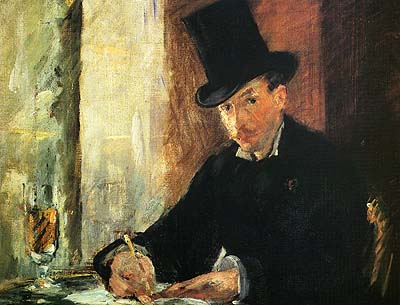 Recently married to Suzanne Leenhoff,
Recently married to Suzanne Leenhoff, the well mannered and well bred Manet was an immaculately groomed member of high society. As Henri Fantin-Latour's Portrait of Manet suggests - this man was the quintessential Parisian flaneur.As a young artist in his early twenties, Manet began an affair with his Dutch piano teacherLeenhoff.
the well mannered and well bred Manet was an immaculately groomed member of high society. As Henri Fantin-Latour's Portrait of Manet suggests - this man was the quintessential Parisian flaneur.As a young artist in his early twenties, Manet began an affair with his Dutch piano teacherLeenhoff.  was more than just reciprocal artistic mentoring. Rumors abound that the two shared romantic feelings but that a true partnership was impossible because of Manet's marriage to Suzanne. In the end,
was more than just reciprocal artistic mentoring. Rumors abound that the two shared romantic feelings but that a true partnership was impossible because of Manet's marriage to Suzanne. In the end, Morisot married Manet’s brother Eugène in 1874. But Manet's unique technical innovations intrigued the likes of Pierre Renoir and Claude Monet and set free the traditional and conservative reigns of academic painting.
Morisot married Manet’s brother Eugène in 1874. But Manet's unique technical innovations intrigued the likes of Pierre Renoir and Claude Monet and set free the traditional and conservative reigns of academic painting.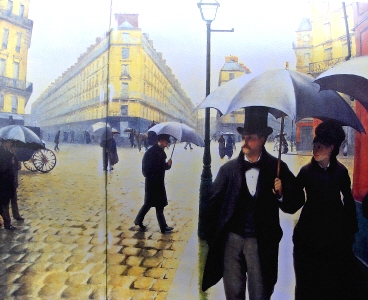
Political events between the years 1867-1871 were turbulent ones for Paris,
 and the Franco-Prussian war left Paris besieged and defeated.
and the Franco-Prussian war left Paris besieged and defeated. Manet turned his eye to these events in his works entitled Execution of Maximilian, Civil War and The Barricade.
Manet turned his eye to these events in his works entitled Execution of Maximilian, Civil War and The Barricade. In 1870, Manet sent his family south to protect them from the fighting in Paris and signed on as a gunner in the National Guard.
In 1870, Manet sent his family south to protect them from the fighting in Paris and signed on as a gunner in the National Guard.  There is much primary documentation in the form of letters to family and friends which expresses Manet's horror and dismay at the war and these paintings stand as testaments to Manet's sentiments. The Execution of Maximilian (1868) reaches out to Goya's Third of May but despite its masterly influence the painting was banned from being exhibited in Paris due to the "Frenchness" of the executioners costume.
There is much primary documentation in the form of letters to family and friends which expresses Manet's horror and dismay at the war and these paintings stand as testaments to Manet's sentiments. The Execution of Maximilian (1868) reaches out to Goya's Third of May but despite its masterly influence the painting was banned from being exhibited in Paris due to the "Frenchness" of the executioners costume. And yet along with his expressions of political disillusionment, Manet also continued producing works such as The Balcony (1868)
And yet along with his expressions of political disillusionment, Manet also continued producing works such as The Balcony (1868) 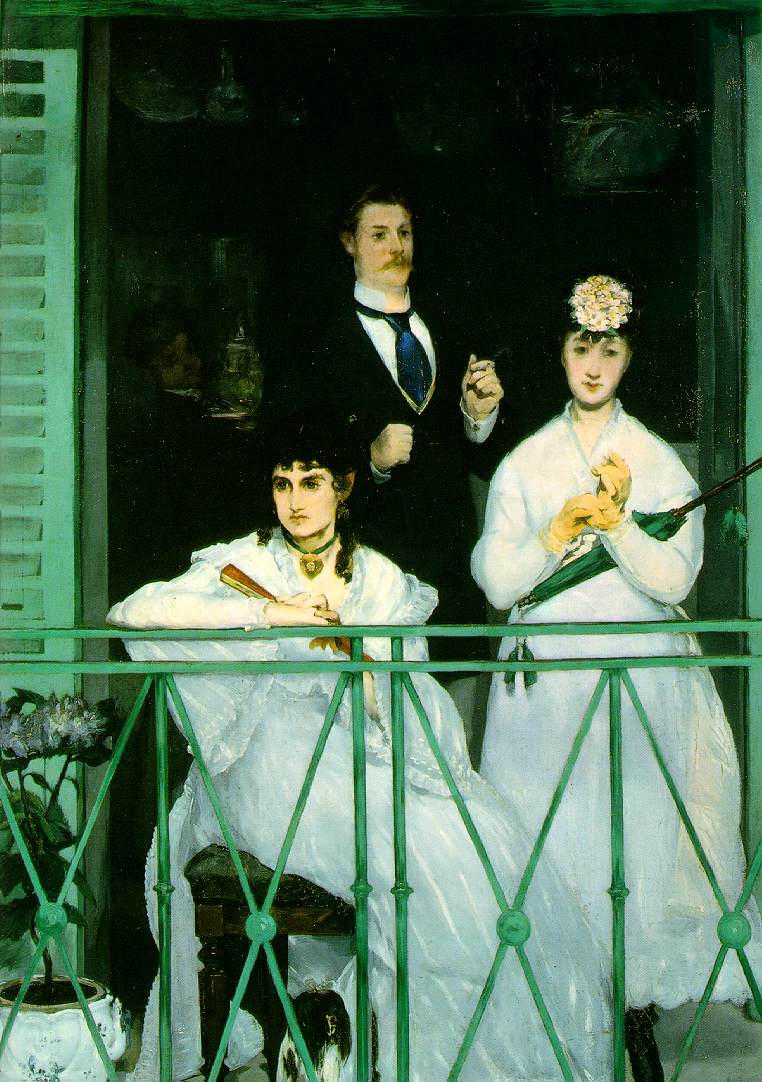 , Portrait of Emile Zola (1868)
, Portrait of Emile Zola (1868) 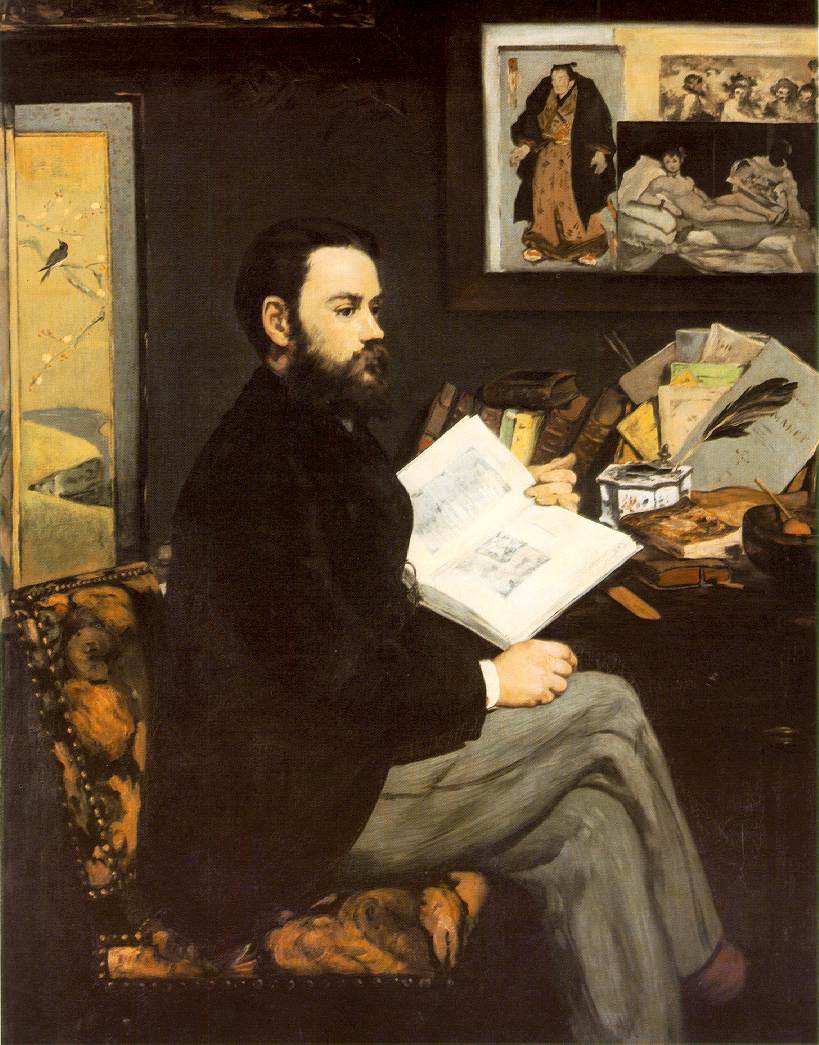 , and The Railroad(1872).
, and The Railroad(1872). 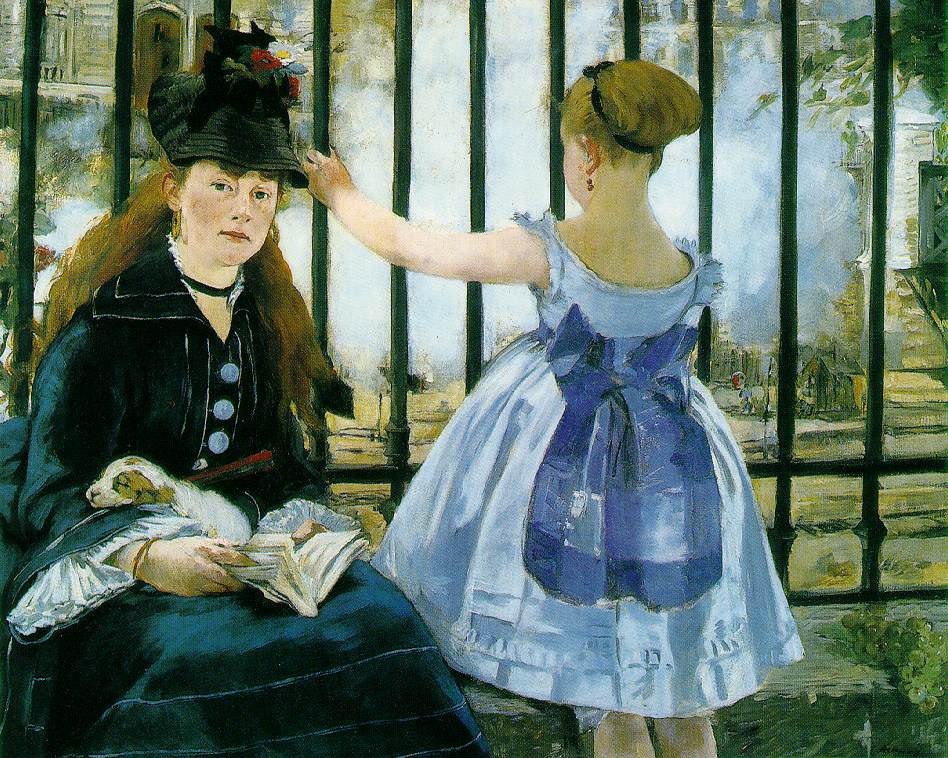
By 1874 Manet's reputation as experimental artist and leader of the Impressionists was firmly established. The Cafe Guerbois,
 near Manet's studio became the gathering spot for Monet, Renoir, Sisley, Degas and Pissaro and although Manet presided over the regular meeting and debates held at the cafe, he was not enthusiastic about his role as leader of the avant-garde. In 1874, when the Impressionists held their first exhibition at Nadar's studio,
near Manet's studio became the gathering spot for Monet, Renoir, Sisley, Degas and Pissaro and although Manet presided over the regular meeting and debates held at the cafe, he was not enthusiastic about his role as leader of the avant-garde. In 1874, when the Impressionists held their first exhibition at Nadar's studio, 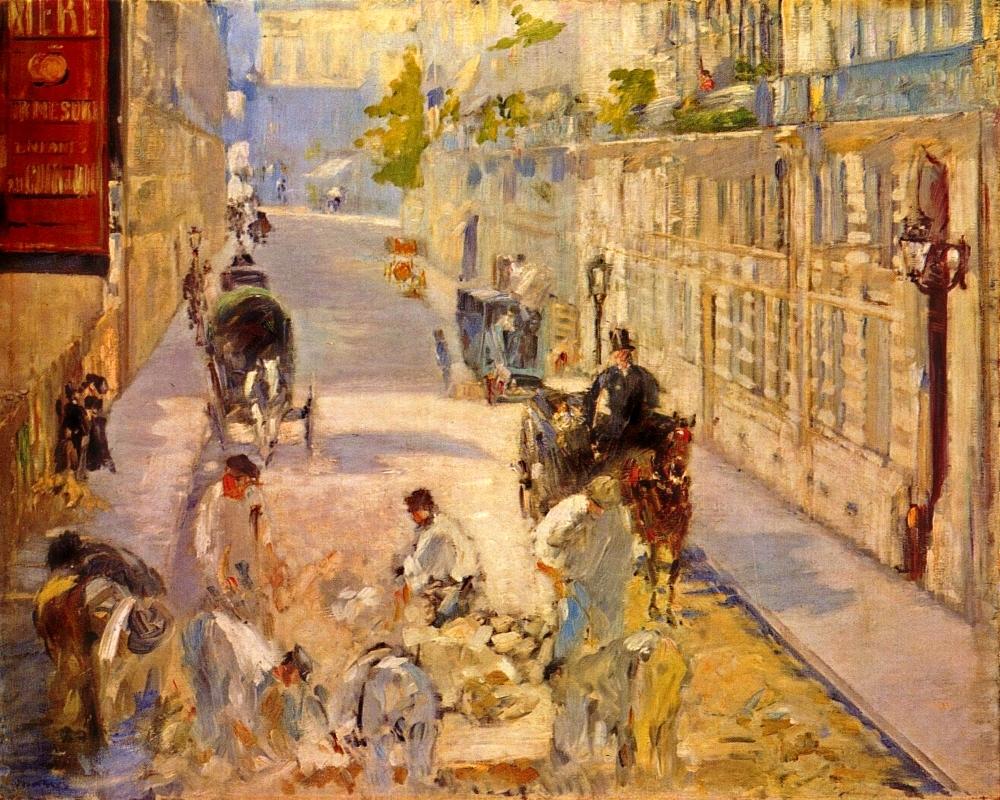 Manet refused to participate. He chose instead to remain focused on the Salon. He never exhibited in any of the eight Impressionist exhibitions and yet by no means did Manet abandon the Impressionists.
Manet refused to participate. He chose instead to remain focused on the Salon. He never exhibited in any of the eight Impressionist exhibitions and yet by no means did Manet abandon the Impressionists.  He worked closely with Monet in Argenteuil during 1874 and often gave financial support to his friends who needed it. It was during this time that Manet came closest to painting in the
He worked closely with Monet in Argenteuil during 1874 and often gave financial support to his friends who needed it. It was during this time that Manet came closest to painting in the Impressionist style.below a painting by Gustave Caillebotte , it shows that by 1888 the bucolic unfucked up paradise of Argenteuil was gone

Walking through Argenteuil today,
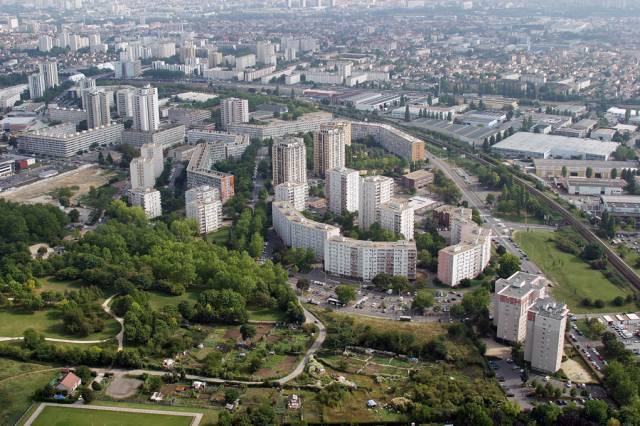 there is an immediate sensation that something is not quite right. It is an ancient site, which has been inhabited for thousands of years.
there is an immediate sensation that something is not quite right. It is an ancient site, which has been inhabited for thousands of years. Running adjacent to the river are the historical arteries of the town, ancient roads with low stacked buildings and houses, many still fulfilling a commercial role
Running adjacent to the river are the historical arteries of the town, ancient roads with low stacked buildings and houses, many still fulfilling a commercial role that has been theirs for generations.It is certainly not an attractive place, albeit very interesting for any students of urbanisation, but I was glad to find that even in these fields of concrete there are still some flowers. Perhaps the most surprising of all are two Art Nouveau constructions
that has been theirs for generations.It is certainly not an attractive place, albeit very interesting for any students of urbanisation, but I was glad to find that even in these fields of concrete there are still some flowers. Perhaps the most surprising of all are two Art Nouveau constructions along the historical axis of the city. At one end, the Post Office designed by the architect Léo Batton in 1909, and at the other, a similarly decorated house dating from 1906. Batton’s bureau de poste is a fascinating polychrome building, featuring curved stone balconies and a handsome carved entrance doorway. In 1935 the city elected a Communist council, and the focus
along the historical axis of the city. At one end, the Post Office designed by the architect Léo Batton in 1909, and at the other, a similarly decorated house dating from 1906. Batton’s bureau de poste is a fascinating polychrome building, featuring curved stone balconies and a handsome carved entrance doorway. In 1935 the city elected a Communist council, and the focus  changed from agriculture to industry. After the war, it would become the heart of the famous ‘ceinture rouge’ around Paris, and would celebrate the worker and the practical. The urbanist Roland Dubrulle drew a new plan for the city, turning the centre around 90° and running a wide central boulevard up to a new town hall from a bridge across the river. On either side, 15 and 20 story tower blocks sprang up, and the population of the town reached 100,000, ten times more than it had been in 1900.
changed from agriculture to industry. After the war, it would become the heart of the famous ‘ceinture rouge’ around Paris, and would celebrate the worker and the practical. The urbanist Roland Dubrulle drew a new plan for the city, turning the centre around 90° and running a wide central boulevard up to a new town hall from a bridge across the river. On either side, 15 and 20 story tower blocks sprang up, and the population of the town reached 100,000, ten times more than it had been in 1900.  The ancient streets that wound through the centre were cut in half by the boulevard and dwarfed by the new scale of the plan, and found themselves demoted to the role of simple side-streets.
The ancient streets that wound through the centre were cut in half by the boulevard and dwarfed by the new scale of the plan, and found themselves demoted to the role of simple side-streets. Painting en plein air Argenteuil(as it is fucked up todayArgenteuil today is the archetypal
Painting en plein air Argenteuil(as it is fucked up todayArgenteuil today is the archetypal  Paris suburb; sprawling, cumbersome and grey, with rows of tower blocks pointing skywards in the place of an artist’s poppy meadow.)
Paris suburb; sprawling, cumbersome and grey, with rows of tower blocks pointing skywards in the place of an artist’s poppy meadow.) Was Monet’s painting ever the reality though, and is there truly nothing left in the town today to inspire an artist
Was Monet’s painting ever the reality though, and is there truly nothing left in the town today to inspire an artist
and Monet's Boat Studio both approach the notions of reflected light and atmosphere of Impressionism but Manet never becomes assimilated into the true Impressionist style.
In his last great masterpiece, Bar at the Folies-Bergère (1882),
 Manet returns again to studio painting, a somber palette and eliminated mid tones. The cafe concert is a theme which Manet had been treating in the late 70's in paintings such as Corner in a Cafe Concert and The Cafe. But here at Bar at the Folies-Bergere, we are no longer spectators, but participants in the painting.
Manet returns again to studio painting, a somber palette and eliminated mid tones. The cafe concert is a theme which Manet had been treating in the late 70's in paintings such as Corner in a Cafe Concert and The Cafe. But here at Bar at the Folies-Bergere, we are no longer spectators, but participants in the painting. 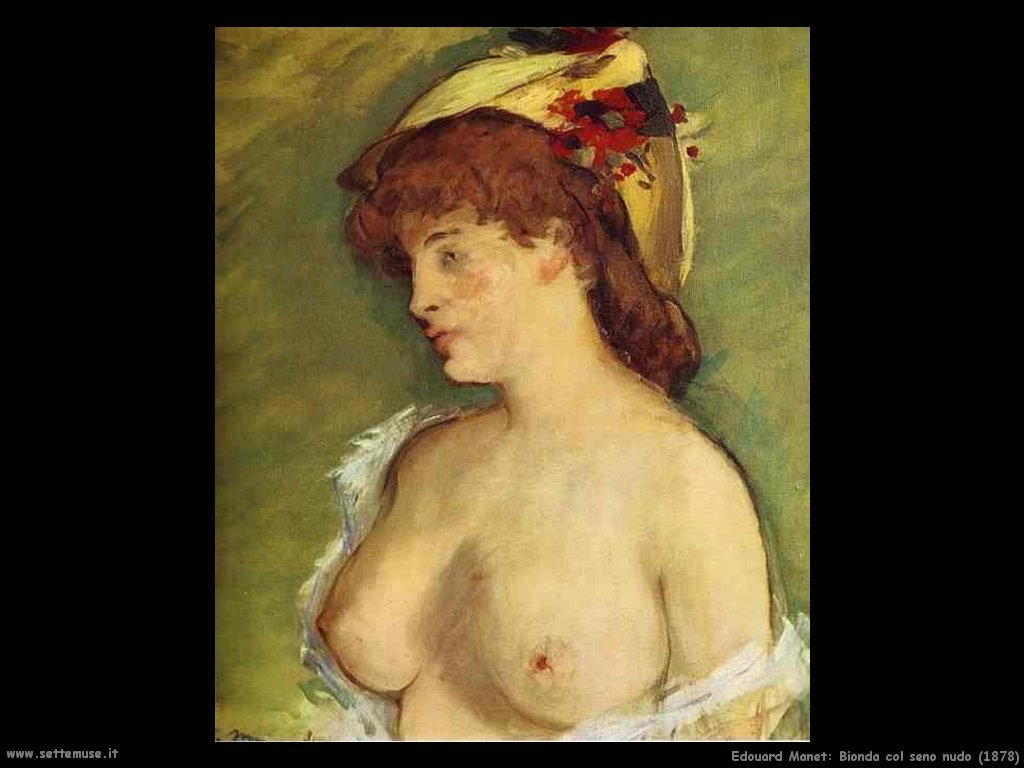 While the Barmaid occupies the center of the piece, the painting is filled with a menagerie of characters from seated couples to trapeze artists. Glittering chandeliers and electric lights fill the upper portion of the work. Here, as in Dejeuner sur l'herbe, optical contradictions abound.
While the Barmaid occupies the center of the piece, the painting is filled with a menagerie of characters from seated couples to trapeze artists. Glittering chandeliers and electric lights fill the upper portion of the work. Here, as in Dejeuner sur l'herbe, optical contradictions abound. 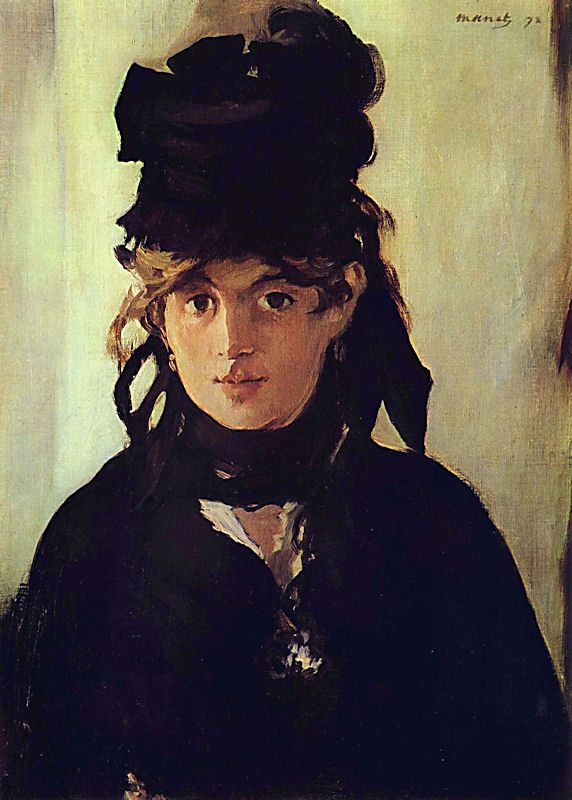
Throughout his oeuvre Manet painted modern day life, yet many of his paintings are so much more than simple mimetic depictions. If Manet's work seems to be full of contradictions, or to employ a lack of perspective from time to time, then perhaps that was the true reality of Paris in Manet's time. Always controversial, Manet sought to record the days of his life using his own unique vision. From beggars, to prostitutes, to the bourgeoisie he sought to be true to himself and to reproduce "not great art, but sincere art." He died, in Paris, on April 30, 1883.
Manet was one of the greatest painters of the 19th century. During his lifetime he was controversial, but his work, though it shocked the public, was hugely admired by artists. His reputation grew rapidly in the 20th century and consequently his best works were acquired by major museums. There are now remarkably few Manets in private collections, almost all in France, and there are only a handful of important pictures by Manet in the United Kingdom – in the National Gallery and the Courtauld Institute in London, as well as other works in Cardiff, Birmingham, and Glasgow.
.jpg)
No comments:
Post a Comment